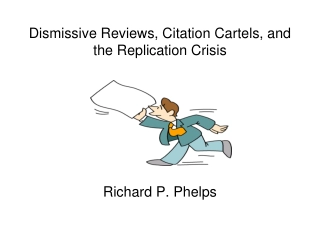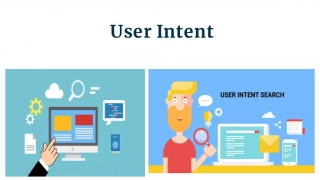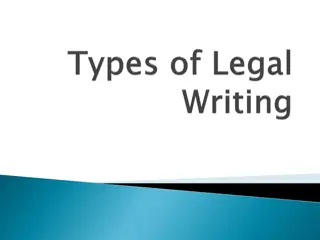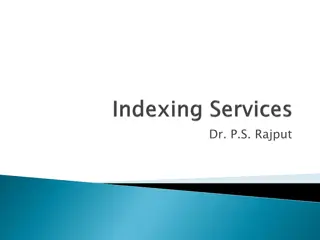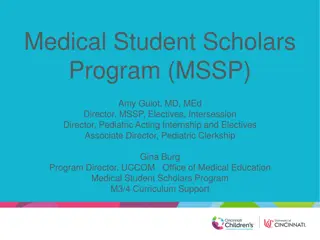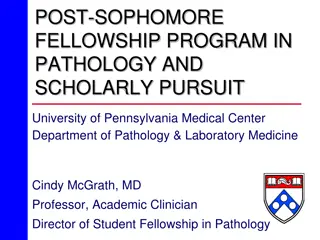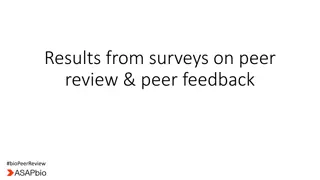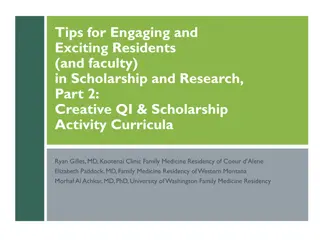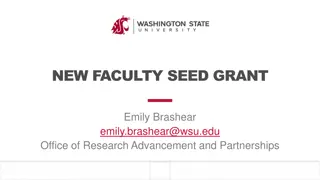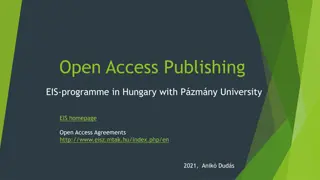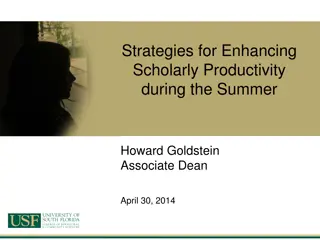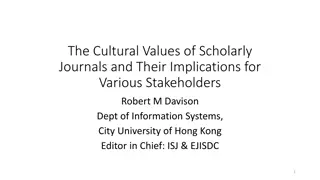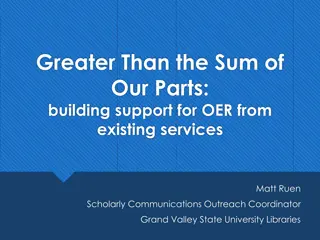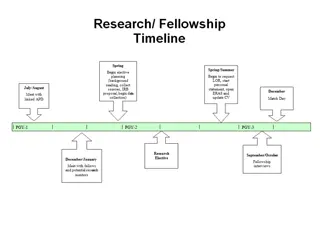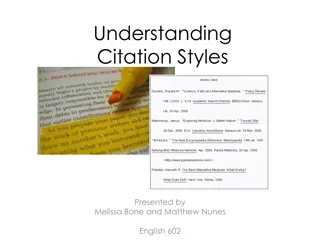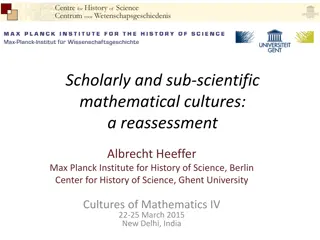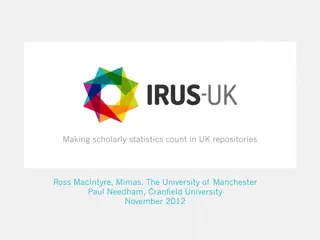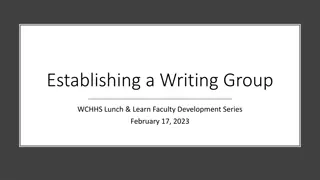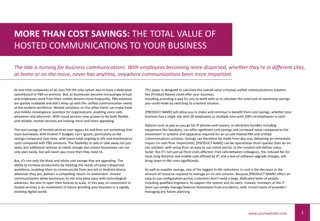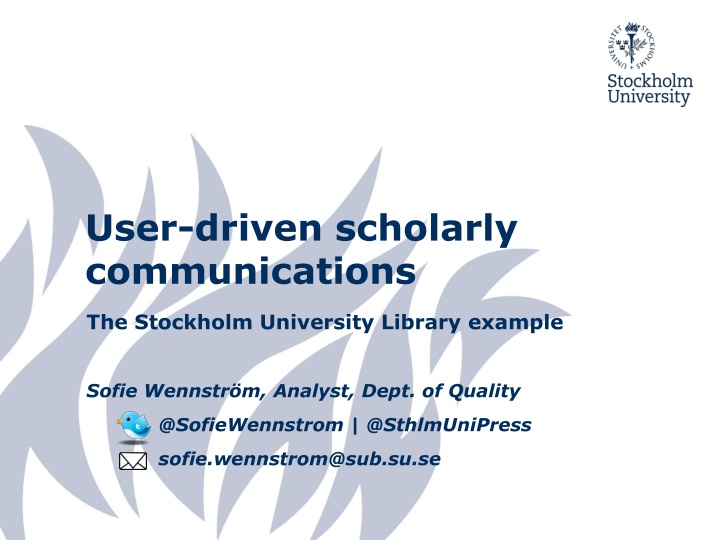
Scholarly Communications at Stockholm University Library - An Overview
Explore the user-driven scholarly communications at Stockholm University Library through its example, including insights on editorial structure, basic structure, book project structure, and what they add to the scholarly community. Discover common questions, costs of publishing, decision-making processes, subject areas covered, dissemination channels used, and memberships in reputable organizations.
Download Presentation

Please find below an Image/Link to download the presentation.
The content on the website is provided AS IS for your information and personal use only. It may not be sold, licensed, or shared on other websites without obtaining consent from the author. If you encounter any issues during the download, it is possible that the publisher has removed the file from their server.
You are allowed to download the files provided on this website for personal or commercial use, subject to the condition that they are used lawfully. All files are the property of their respective owners.
The content on the website is provided AS IS for your information and personal use only. It may not be sold, licensed, or shared on other websites without obtaining consent from the author.
E N D
Presentation Transcript
User-driven scholarly communications The Stockholm University Library example Sofie Wennstr m, Analyst, Dept. of Quality @SofieWennstrom | @SthlmUniPress sofie.wennstrom@sub.su.se
Scholarly Communication
Basic Structure
Editorial Structure
Book Project Structure
What we add
Thank you Questions? Useful Links www.stockholmuniversitypress.se http://blog.stockholmuniversitypress.se http://www.su.se/english/ http://www.ubiquitypress.com http://www.oapen.org/home /Sofie Wennstr m, Stockholm University Library, Sweden @SofieWennstrom | @SthlmUniPress
Common Questions The cost of publishing? GBP 300 per journal article Approx. GBP 3,250 for a standard book (200 pages) Who makes decisions? The Publishing Committee, based on recommendations from the editorial boards Which subject areas do you cover? All the areas where there s a demand for reasonably priced OA publishing An Editorial Board for the subject area is also needed What dissemination channels do you use? OAPEN for online books Amazon & Bokinfo (SWE) for Print-on-Demand books Subject area databases & Search Engine Optimisation for journals (takes time to fulful criteria) Approved by the Norwegian Register for Scientific Publishers (Level 1) & The Danish Bibliometric Indicator What organisations are you members of? OASPA,DOAJ, Ubiquity Partner Network, CrossRef & COPE (the last two via Ubiquity Press) /Sofie Wennstr m, Stockholm University Library, Sweden @SofieWennstrom | @SthlmUniPress
Speaker text Slide 1: - Introduction I d like to talk to you today about the governing principles of the publication services at Stockholm University Library, by using the Stockholm University Press as an example. Stockholm university has over 3,300 faculty members, and more than 69,000 registered students (29,000 full time), mostly HSS, but strong in some science areas as well. We needed an upgraded publishing service for our researchers, and there was a demand for more Open Access options. The press was formed based on a decision of the Vice-Chancellor in December 2012, who delegate to the Library to take care of the running of this operation. The request was to form an Open Access press, on a non-profit basis (following the principles of the entire university). An early decision in the process of forming the press, was to ensure it had a clear focus on the users, the researchers, to ensure that the work effort made sense from the perspective of the entire university. The press has been allowed to grow slowly, and in accordance with the users needs, and that is what I would like to describe today. Slide 2:- Scholarly Communication Meaning of research & publishing: Exchange of ideas Another meaning-making action intrinsic in the process is to Review others work to be inspired and to help them get better The scientific process is driven by creating possibilities to discuss and develop ideas into something greater through publication of papers This process is built-in to the university systems, where publishing plays an important part not only to drive development but also by the evaluation practices. A publishing venture at a university need to take all this into account and make sure to follow this practical syllogism Science isn t done until it s communicated! (Sir Mark Walport, UK Science Chief, at LIBER Annual Conference 2015, London, UK): Based on this quote, we can form a practical syllogism to explain what drives the scholarly communication process: Premise 1) All researchers should communicate, Premise 2) I am a researcher; Conclusion) I need to publish to communicate Our role as a publisher is then to simplify this process to leave more room for the actual research being done. So, how is this done then? Slide 3 Basic Structure Stockholm University Press is a part of the university structure, as it is a part of the university as a whole. The governing bodies of book series and journals is formed by researchers. The Publishing Committee include elected members of senior faculty along with representatives from the Library staff. The Editorial Boards are formed of active researchers in each respective subject area, based on their own ideas and scope. It is also common to recruit board members from other institutions or countries, to facilitate networking and external review External reviewers no one can review a manuscript from their own department or institution, so all reviewers should be invited on this premise, based on the networks of the board members The administration is a part of the university, and thus have access to databases and information channels to facilitate the support to researchers as authors, editors and reviewers No library staff works solely with press matters. They have other duties at the library to ensure that the perspective about the meaning-making process is in place (I, for example work with forming strategies for learning and instruction about all library services to both researchers and students) Slide 4 Editorial Structure The editorial structure is built on the collaboration between the different stakeholders of the process Authors submit papers, proposals and full manuscripts The Editorial Boards assess the manuscripts and appoints reviewers and make decisions or recommendations of decisions (the structure is a little bit different between journals and books) The Library/Press staff facilitates the process and run the day-to-day management The Publishing Committee makes final decisions about proposals (books and journals) and book manbuscripts The Journal Editors make decisions about the acceptance of single articles The Readers/Users are a part of the cake, as they can come with feedback through open commenting sections, and by analysis of usage patterns The different pieces of this cake interlaces with each other, and the press processes are built to facilitate these interactions, by for example online systems for handling the review process for books and journals. We share these systems with the network of presses belonging to the Ubiquity Partner Network, and can thus take advantage of developments being made without having to focus on them ourselves, so they also make a part of the same delicious cake. Researchers at the University forms Editorial Board groups who are responsible for the assessment of proposals and book manuscripts and to select and communicate with the reviewers of both these incarnations of book projects. The Stockholm University Press staff is assisting editorial boards with system practices, guidelines, instructions, liaising with our partner press, assisting authors during submission, answering questions, handling licencing queries and many more things. The Publishing Committee consists of representatives from all Faculties at Stockholm University and representatives from the Press staff. Their job is to establish ethical guidelines, contributing to the scope of the entire press bit most importantly they make the final decisions on whether or not to publish a book or a journal. They will quality check all final recommendations from editorial boards, to ensure that the process has been correctly handled with a special representative focussing on publication ethics The Ubiquity Press and their network structure are mostly involved with activities after the acceptance date of projects, but will also assist with the day-to-day running of journals, peer review systems but are also involved in giving advice on the editorial processes. The network of presses serves as a point of reflection and collaboration The Readers/users of our services is also a part of the structure, as most of our ideas for improvements and development come from their comments and suggestions. Slide 5 Book Project Structure This is the Stockholm University Press workflow for books. Starts with a proposal through a first screening by editors and reviewers decision in Publishing Committee if accept then a contract with the authors and full manuscript submission the second review process (can include the same reviewers as for the proposal) Author correct suggested revisions Final assessment by Editorial Board and Publishing Committee Publish e-book with print-on-demand option through for the major online book stores (Amazon, and Book info in Sweden etc.) The quality assurance part is managed by the library/press staff in close collaboration with the editorial boards, by way of the online systems The production process (typesetting, copy-editing, printing) is managed by our service partner Ubiquity Press. SUP adds a layer to the process by providing a home for the strategic planning of editorial work and system management though UP. Slide 6 What we add What Stockholm University Press (SUP) add The rationality of publishing, based on what researchers need to do to earn merit SUP work to accelerate this process and to create agency for researchers to act in two ways. A well-oiled publishing structure without extra costs or too much additional work for the authors and editors A university-wide framework for talking about the rationality of publishing by adding knowledge and skills to the organisation Learning in a social context the press itself becomes a learning tool for the entire university, we can teach young scholars that an alternative route to the traditional channels is possible Keeping up structures to encourage ethical publishing guidelines and best practices to archive the intended goal to communicate So, the most important task of the publisher is to support, enhance and drive development to support the social nature of the science-making process. The press is there to follow the practical syllogism of the researcher I m a researcher, therefore I publish to communicate my results and conclusions. We create a platform to take care of the practical work, to let the researchers focus on their expertise, by running an agile and responsive organisation where we are not afraid to adjust to changes in the landscape Aims & Considerations We are working on the issues of dissemination of knowledge about publishing strategies, and to create a new system for merits through editorial work, in addition to the the author role. We also create platforms to look at publishing metrics from different perspectives, to serve the HSS areas but also to add recognition for the work intrinsic in the peer-review process. Final Remark One could argue that starting a new press without any of the old measures of credibility in place is actually not supporting researchers problems with finding the right publication channels for dissemination of their work, we could be seen as just

